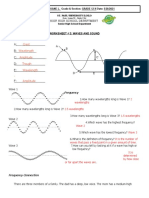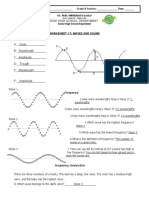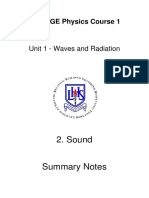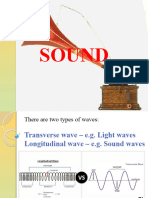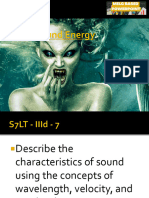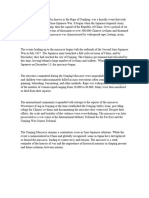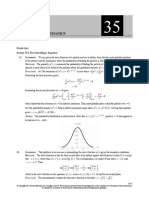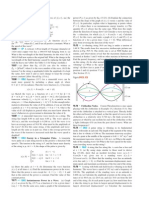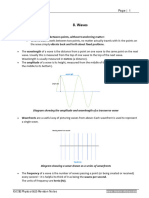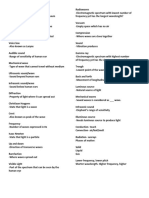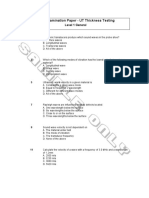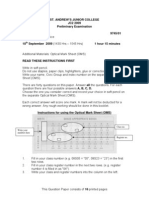Sounds Waves
This activity uses PhET simulation – Waves Intro. Select the sound option.
This is a guided inquiry task. You must read and follow the instructions carefully.
1. Amplitude of sound waves
Tick Play Tone and Particles. Move the Amplitude slider to halfway.
Press the green button on the speaker.
What happens to the particles?
When sound waves start, the air molecule closest to the speaker vibrates back and then forth.
When it gets pushed back, it hits the air molecule next to it, which then also vibrates back and
forth and it's a ripple effect that keeps going. The individual air molecules do not "travel" with the
wave but really they just vibrate back and forth transferring the pulse away from the speaker.
Move the Amplitude slider up and down. How does the sound change?
When I move the Amplitude slider up, the sound changes, it gets louder than when it was in the
middle. When I move it down, the sound gets lower and dims. This is because the amplitude is
how high and low a sound wave is. Higher(taller) sound waves are louder to us than the
lower(shorter) sound waves.
How does the motion of the particles change?
What i noticed while moving the amplitude higher and lower is that the higher i moved it, the
more distinct the waves are. The particles vibrate further and we can see clearly where the air
particles are compressing and the decompressing spots. When we turn the amplitude lower, the
sir particles are still moving but instead of seeing them go in waves, it's just vibrating slightly.
This shows us that the more they vibrate, the taller that wave is.
Does the position of the pattern change? The pause button and tape might help.
When I pressed the green button for the sound to start, I focused my attention on only one red
particle. I saw that once the waves start hitting it, it does move but the pattern does not change.
This particle will vibrate and hit the next particle but it will not move further than the spot it's on.
For this reason, the position of the pattern does not change.
Click the Waves button.
The Wave setting shows areas where the particles are pushed together as light coloured and where they
are far apart as dark.
Vary the amplitude and check what you wrote about the position of the pattern.
This study source was downloaded by 100000867625491 from CourseHero.com on 02-12-2024 21:10:02 GMT -06:00
https://www.coursehero.com/file/71194912/lab-12/
� Sound waves are pressure waves in the air. In areas where the particles are
compressed the air pressure is high and where the particles are spread out (we call
that rarefaction) the pressure is low.
The wavelength of a sound wave is the distance between 2 compression areas or 2
rarefaction areas. Use the pause button and tape to measure the wavelength of
your soundwave.
105.3 cm = 1.053 m
You can use the pressure meter tool to keep track of the pressure at a particular
place over time. Place one of the detectors into the middle of your box.
Use the pause button to see that a high pressure reading matches a bright band
and area of compression and that a low pressure reading matches an area of
rarefaction.
Set the amplitude to zero. This is the where the particles would be if there is no
sound.
Slowly increase the amplitude and look at the pressure tool.
Sketch the shape of the pressure wave on the diagrams below.
Low Amplitude High Amplitude
The time it takes for a full sound wave to pass a point is called the period of the
wave. Use the stopwatch tool with the pressure tool to measure the time it takes
for 10 compression areas to pass.
Low Amplitude: 30.44 milliseconds
This study source was downloaded by 100000867625491 from CourseHero.com on 02-12-2024 21:10:02 GMT -06:00
https://www.coursehero.com/file/71194912/lab-12/
� Calculate the period High Amplitude: 30.57 milliseconds
2. Frequency of sound waves
Tick Play Tone and Particles. Move the Frequency and Amplitude slider to
Halfway.
Press the green button on the speaker.
Move the Frequency slider up and down. How does the sound change?
While moving the Frequency slider up and down we can hear a clear difference from when it's
lower and higher. The higher we slide the bar, the higher pitch it gets, the lower we slide it the
lower the pitch gets. When we increase the frequency, it increases the amount of waves there
are. Higher frequency equals more pulses and resulting in a higher pitch in our ears.
How does the motion of the particles change?
Frequency is the amount of pulses the transverse wave does per second. One way i learned to
remember this is by remembering that the frequency is how FREQUENT it happens. What I
noticed that was happening while increasing the frequency was that the air particles were
moving at a faster rate. When I lowered it, they would slow down again.
Click the Waves button.
Reduce the frequency to minimum. Use the pause and tape tool to measure the
wavelength. Repeat for maximum frequency.
min Frequency wavelength = 151.9 m
max Frequency wavelength = .805 m
You can use the pressure meter tool to keep track of the pressure at a particular
place over time. Place one of the detectors into the middle of your box.
Slowly vary the frequency using the slider, monitor the pressure wave.
Sketch the shape of the pressure wave on the diagrams below.
This study source was downloaded by 100000867625491 from CourseHero.com on 02-12-2024 21:10:02 GMT -06:00
https://www.coursehero.com/file/71194912/lab-12/
� Low Frequency High Frequency
Use the stopwatch tool with the pressure tool to measure the time it takes for 10
compression areas to pass. Use the times to calculate the period and complete the
table below.
Low Frequency High Frequency
Time for 10 waves 50.18 ms 22.66 ms
/ ms
Period /s 0.05018 seconds 0.02266 seconds
This study source was downloaded by 100000867625491 from CourseHero.com on 02-12-2024 21:10:02 GMT -06:00
https://www.coursehero.com/file/71194912/lab-12/
� SUMMARY TASK
1. Look at the words below. Consider whether you associate them with amplitude or
frequency and place them
into the table.
Pitch, Volume, Wavelength, Period, Vibration size
Amplitude Frequency
● Volume ● Pitch
● Period ● Wave length
● Vibration Size
2. Draw on the diagram a wavelength between compression areas and a wavelength
between rarefactions.
This study source was downloaded by 100000867625491 from CourseHero.com on 02-12-2024 21:10:02 GMT -06:00
https://www.coursehero.com/file/71194912/lab-12/
� Check they are the same length.
Compression wavelengths 71.5 cm Rarefaction wavelengths 71.5 cm
This study source was downloaded by 100000867625491 from CourseHero.com on 02-12-2024 21:10:02 GMT -06:00
https://www.coursehero.com/file/71194912/lab-12/
Powered by TCPDF (www.tcpdf.org)
